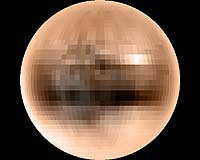by iamlucky13 » Tue Jan 08, 2008 7:59 pm
You'll have to mark your calendar a few weeks to months later. New Horizons will fly past Pluto and then Charon facing them and observing constantly for a period of several weeks. It's not until Pluto has faded in the distance that it will turn its antenna to earth and share all the images and data it took. Because of the distance and resultant low bandwidth, it will take several months to send all that data to earth.
The one-shot nature of the mission is part of why the Jupiter flyby was so important. Not only did it cut two years off the trip, but it let the team do a complete test of system ahead of time (and as a bonus collected some new data on Jupiter).
For fun, here's a comparison of the best image we currently have of Pluto and the peak resolution we can expect from New Horizons when it flies by in 2015:

(image derived from colors exposed during Charon eclipses)

(Saturnian moon Tethys at 50 m/pixel in the
full size)
You'll have to mark your calendar a few weeks to months later. New Horizons will fly past Pluto and then Charon facing them and observing constantly for a period of several weeks. It's not until Pluto has faded in the distance that it will turn its antenna to earth and share all the images and data it took. Because of the distance and resultant low bandwidth, it will take several months to send all that data to earth.
The one-shot nature of the mission is part of why the Jupiter flyby was so important. Not only did it cut two years off the trip, but it let the team do a complete test of system ahead of time (and as a bonus collected some new data on Jupiter).
For fun, here's a comparison of the best image we currently have of Pluto and the peak resolution we can expect from New Horizons when it flies by in 2015:
[img]http://www.spacedaily.com/images/pluto-hubble-true-color-surface-res-bg.jpg[/img]
(image derived from colors exposed during Charon eclipses)
[img]http://saturn.jpl.nasa.gov/multimedia/images/moons/images/PIA08379-br500.jpg[/img]
(Saturnian moon Tethys at 50 m/pixel in the [url=http://photojournal.jpl.nasa.gov/figures/PIA08379_fig1.jpg]full size[/url])